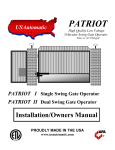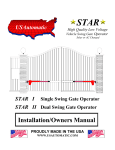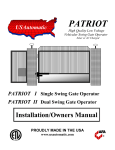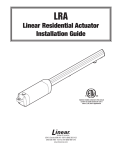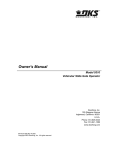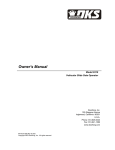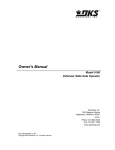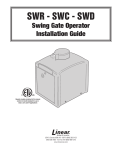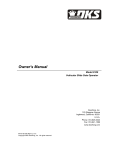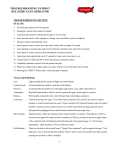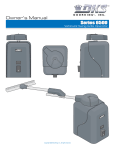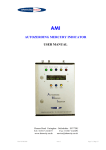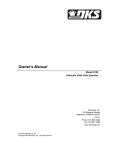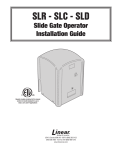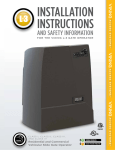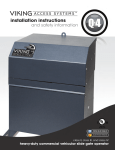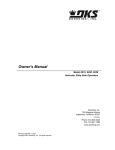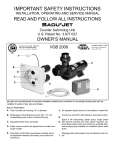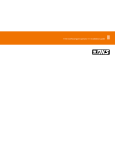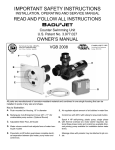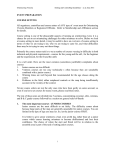Download Patriot RSL Manual
Transcript
USAutomatic PATRIOT RSL High Quality Low Voltage Vehicular Slide Gate Operator Solar or AC Charged PATRIOT RSL Slide Gate Operator Installation/Owners Manual PROUDLY MADE IN THE USA WWW.USAUTOMATIC.COM INTRODUCTION This operator is intended to be installed on vehicular Class I or Class II gates as defined by UL 325. Maximum gate load not to exceed 600 pounds. PLEASE READ THIS ENTIRE MANUAL CAREFULLY PRIOR TO INSTALLATION. In doing so, along with performance of the installation in step-by-step order, you will achieve optimal results. We strongly recommend that all installation and service personnel pay particularly close attention to the safety systems section of this manual and UL 325. In addition to the current sense feature that is provided, other safety devices are necessary to make each particular installation as safe as possible to reduce the risk of personal injury and/or property damage. A trained and authorized service technician or the factory should be consulted for assistance. Cautions - Very Important Do not attempt to enter the gate area while the gate is moving. Wait until the gate comes to a complete stop. Operate the gate only when it is fully visible, free of persons or obstructions, and properly adjusted. Do not allow children to play in the area of the gate. Do not allow anyone to ride on the gate. Do not allow children to play with the remote control or any other activation device. Do not attempt to "beat the gate" while the gate is opening or closing. This is extremely dangerous. Test the current sense feature and all safety devices regularly to insure correct operation. Study the entire Safety Section, paying particularly close attention to the Entrapment zones on page 17-21 and be aware of these areas not only during use but also during any adjustments to the unit. Other Safety Standards All control stations should be located at least 6 feet from any moving part of the gate or operator. Do not ever install any control device where a user will be tempted to reach through the gate or fence to activate a gate. © USAutomatic, Inc., 2001 rev N/C All rights reserved. No part of this may be reproduced by any means without the expressed written consent of the publisher. 1 Table Of Contents Page Introduction......................................................................................1 Table of Contents.............................................................................2 General Requirements/Gate Qualifications & Applications ...........3 Importance of a Properly Designed Gate.........................................4 Mounting Site Review .....................................................................4 Parts Included List ...........................................................................5 Operator Illustration/Description.....................................................6 Mounting Operator...........................................................................7 Mounting Operator /Post Mount Installation...................................8 Pad Mount Installation.....................................................................9 Mounting Chain Brackets/Connecting Chain.................................10 Installation of Charging Source ......................................................11 Installation of Secondary Entrapment Siren/Safety Placards .........11 Final Adjustments ........................................................................ 11,12 Current Sense Adjustment ..............................................................12 Limit Switches/Installing Cover .....................................................13 Circuit Board & Terminal Description ...........................................14 Function of Programming Switch Settings.................................. 15-16 Emergency Manual Release............................................................16 Safety Section .............................................................................. 17-21 Troubleshooting Introduction .........................................................22 Troubleshooting Guide ................................................................ 23-25 Accessory Wiring Diagrams ........................................................ 26-30 Magnetic Wire Sensing Loops..................................................... 31-32 Warranty Statement / Mail in Registration..........................Back Cover 2 GENERAL REQUIREMENTS General hand/tools such as wrenches [7/16, 3/4], tape measure, level, clamps, chain cutter, etc. are required. Your particular installation may require a drill, welder or other hardware not provided. Concrete pad mounting by a qualified installer is the recommended method of securing the operator. Post mounting is also acceptable, additional support may be needed. BATTERY REQUIRED FOR OPERATION (NOT INCLUDED). We recommend a 12-volt deep cycle marine battery. The cable harness supplied with the operator is designed for bolt type adapters such as ones found on most marine batteries. IMPORTANT CAUTIONS: 1. Do not test or operate this unit without first ensuring that all hardware is correctly installed, limit nuts are securely locked in place with the limit locking plate and all objects are clear of sprockets and chain. 2. Do not perform any welding with the control board or the battery connected. Serious damage to the control board and/or battery can occur if attempted. 3. Loose clothing can get caught in chain and sprockets resulting in bodily harm. GATE QUALIFICATIONS/APPLICATIONS GATE LENGTH/WEIGHT This gate operator is rated for vehicular class I or class II slide gates up to 24 feet in length and up to 600 pounds in weight as defined by UL325. If your gate exceeds either one of these limits, please consult a qualified technician or the factory for alternative solutions. Note: High quality rollers with bearings will allow your gate to operate with minimal drag (minimal friction) and will decrease the load on the gate operator. Many type of slide gate designs exist. Choose a design that will decrease friction and required torque. GATE CYCLES PER DAY Solar charged systems should not exceed 15 complete open/close cycles per day without additional solar panels. This gate operator, whether AC or Solar charged, should never be used in applications, which exceed 100 complete open/close cycles per day. Cycles can be decreased by holding the gate open during high cycle time periods. If more cycles are required, a high traffic gate opener should be used. 3 IMPORTANCE OF A PROPERLY DESIGNED GATE As a general rule, a gate, which is to be automatically operated, must be stronger and smoother than one, which will be manually operated. Since the gate is a major component of the system, great care and concern must be given to the gate design. A GATE OPERATOR CANNOT OVERCOME A POORLY DESIGNED GATE. A. B. C. D. Does the gate slide smoothly without binds or excessive resistance? Slide gates should slide level and plumb if possible to prevent the operator from having to pull the gate up or down grade when opening or closing. Low quality wheels and rollers usually create drag, which will cause operator problems. The use of high quality bearing wheels and rollers are highly recommended. Is the gate frame of substantial strength without excessive weight? Will the frame withstand normal wind load conditions without sway or vibration? Will the gate hit the catch correctly without being hand-guided or pushed into the catch? Are the bearings / wheels suited for the number of cycles expected per day? Is the track area designed to keep dirt and rocks from obstructing the gate movement? If any of these problems exist, they must be corrected to achieve a reliable automatic gate system. MOUNTING SITE REVIEW Installers should ask themselves these questions prior to installation and predetermine the solution to any problems, which may occur. A. Does sufficient space exist for mounting and future servicing of the operator? B. *Will the unit open the gate by sliding to the left or the right? (see page 12 note #4) C. How will the chain brackets attach to the gate? D. How will the operator be mounted (on a pad or on a post)? E. How will the charging unit (AC or Solar) be brought to the control box? F. How and where will the solar panel mount if solar charged, so that optimum sunlight is received? G. How will control wiring, if any, be brought to the control box? H. Have all safety concerns been addressed? (See Safety Section Pgs. 17-21) NOTE: *Standing on the operator side of the gate, an operator installed to the left of the drive is a left hand installation, an operator installed to the right is a right hand installation. 4 PARTS INCLUDED The Patriot RSL slide gate operator is shipped in two separate boxes. One box contains the operator chassis and cover. The second box contains charging device (with bracket for solar), secondary entrapment siren, chain brackets, chain, transmitter, chain adjustment bolts, emergency release access cover and the installation/user manual with safety placards. 5 watt Solar Panel and Bracket Chain Bracket 2 supplied 2”x6” (1/2” hole) Battery Charger OR 2- ½” x 6” Chain Adjustment Bolts 4- ½ inch Nuts CHAIN #41 3 – 10’ boxes 4 – Master links 1 – Multi-code Transmitter Multi code Receiver Gear motor UV treated Polyethylene Cover Patriot Control Board 4 – ¼” bolts Operator Chassis ! WARNING A MOVING GATE HAS THE POTENTIAL OF INFLICTING SERIOUS INJURY OR DEATH Persons are to keep clear! The gate is able to be moved without prior warning. Do not let children operate the gate or play in the gate area. Persons are to operate the gate only when the gate area is in sight and free of people and obstructions. Safety Placards 2 supplied. Placards to be installed in plain view and on both sides of the gate. Secondary Entrapment Siren +12vdc 2 push in snaps Emergency release access cover 1 – cover, screw and nut • Placards (Two supplied) should be visible from inside and outside of gate. NOTE: 12 Volt DC deep cycle marine battery required. (Not Included) 5 Operator Illustration and Descriptions TOP VIEW Gate Output drive sprocket Chain rollers Gate bracket Chain adjustment bolt Limit Plate assembly Limit adjustment cams Radio receiver Gear motor Pillow block bearings Safety disk Emergency manual release locking bar Emergency release knob Illustration 1 FRONT VIEW Drive chain/Gear motor Emergency release knob Patriot control board Emergency manual Release locking bar Cover bolt holes 4 plcs Post mount sleeve Illustration 2 REAR VIEW Output drive sprocket Battery Compartment Chain rollers Chain Pad mounting holes Illustration 3 Note: USAutomatic is not responsible for failure to comply with UL325 standards, local building codes or improper installations. 6 Mounting Operator NOTE: Do not mount in areas by automatic sprinklers, or flood-prone areas. It is important that the control board, control devices, and the battery compartment remain dry. Correct Installation Incorrect Installation GATE GATE Illustration 4 Illustration 5 Correct Installation Incorrect Installation Illustration 6 Illustration 7 2.00 inches 1.75 – 2.00 inches 3.25 - 3.50 inches Post or pad mount Correct dimensions for installed operator. Illustration 8 7 Mounting Operator PAD MOUNT: The operator base has four predrilled holes and four access holes, which are covered with press in hole plugs. These holes are sized to accommodate ½ anchor bolts and the plugged hole will accept a standard size ¾ inch socket. Keep the operator parallel with the gate while securing. See illustrations 9,13 and 14 for dimensions. POST MOUNT: The operator base is equipped with a four-inch post receiver located on the bottom of the base. This receiver will accept a square or round four-inch post. Keep the operator parallel with the gate and level while securing in place. See illustration 10 for dimensions. Set the operator in place (pad or post). Ensure that the chain bolts once installed will be properly aligned with the chain rollers, see illustrations 4 – 8. Once alignment is verified secure operator in place using bolts for pad installation and welding for post installation. Keep the operator parallel with the gate while securing in place. Anchor bolt access holes (4 places). Use with pad mount or post mount with frame. Reciever Post Receiver post located on bottom of operator base. Illustration 9 NOTE: Regardless of mounting method ensure that operator base does not extend into the driveway area, where damage from traffic could occur. STEP 1 Post Mount Installation POST SPECIFICATIONS Steel post is an optional mounting method. The type of post the operator is designed to handle is a 4 inch round or square thick wall post. The operator can be installed directly onto the post or a steel frame can be constructed on the top of post. If the method chosen is to construct a frame see dimensions in pad mount section (Illustrations 13,14) for bolt locations and size. If the direct post mount option is chosen use the dimensions that follow to install, also consider that additional bracing might be needed. POST LOCATION TO GATE EDGE AND HOLE PREPARATION GATE BOTTOM VIEW 4” steel post (round or square) 8.75 inches (measured from gate edge to post edge.) 8.75 inches (measured from operator edge to post edge) When determining post location ensure that the operator’s outer edge is a safe distance away from the drive to avoid damage from traffic. See illustration 13 for operator base overall dimensions. Illustration 10 Post must be parallel to gate edge. Hole depth should be at least 36 inches and bell shaped to reduce operator movement to a minimum. The post must be concreted in place NOTE: Remember to mount the operator high enough above ground level so that the post and operator can be welded securely. 8 STEP 1 Pad Mount Installation CONCRETE PAD CONSTRUCTION The mounting foundation must be very stable and of sufficient strength to prevent any movement. Mounting site must be clear of flooding. TOP VIEW PAD Cross Section View 4 inch minimum 20” MINIMUM 24 inch minimum Illustration 12 24 inch minimum Illustration 11 28” MINIMUM Illustration shown is for dirt surface area. Surface areas of different material may require different pad dimensions. When determining pad location ensure that the operator’s outer edge is a safe distance away from the driveway to avoid damage from traffic. CONCRETE PAD LOCATION TO GATE GATE TOP VIEW 20” MINIMUM Maximum Distance between gate edge and pad edge 2.0” Optimum 1.75” Illustration 13 28” MINIMUM CONCRETE PAD ANCHOR BOLT LOCATION Concrete pad top view measures 20” x 28”. This allows for 4” of concrete between the anchor bolts and the outer edge of the pad. Use the drawing below to locate the four anchor bolts. 4 inches TOP VIEW PAD Gate Side Locate anchor boltholes on gate side corners using these dimensions. 4 inches 20” MINIMUM 12 inches This hole is for ¾ electrical conduit use dimensions shown. 3.3 inches 20 inches 1 inch Illustration 14 28” MINIMUM Note: USAutomatic is not responsible for failure to comply with UL325 standards, local building codes or improper installations. 9 STEP 2 Mounting of Chain Brackets to Gate With the operator securely mounted use the following procedure to locate and install gate brackets to gate ends. 1. Install the chain adjustment bolt into the chain bracket as shown in illustration 15 below. 2. Slide the gate fully open. Using the diagram below locate the correct position for the gate bracket. Clamp the bracket in place and repeat for gate in the fully closed position. Before welding gate brackets in place refer to illustrations 4 – 8 to ensure correct installation. Once alignment is correct weld chain brackets in place. TOP VIEW (GATE FRAME 2”) Outer nut Chain Bracket Inner nut Chain Adjustment Bolt ½” Nut (2 plcs) Illustration 15 Install chain adjustment bolts as shown to allow for maximum tension adjustment. Illustration 16 STEP 3 Connecting Chain Using the master links supplied connect one end of chain to one of the chain adjustment bolts. Use additional master links to connect chain together as needed to route chain through the operator (See Illustration 3,16). In most installations the chain will have to be cut to the desired length. To determine the desired chain length loosen the chain adjustment bolts to allow for maximum adjustment (illustration 15). Pull the emergency release knob to allow the chain to roll freely through the operator. Pull the chain to mate up with the remaining chain adjustment bolt and mark link that needs to be cut. Once link is cut install master link and connect to chain adjustment bolt. CHAIN TENSION ADJUSTMENT The outer ½ inch nut on the chain adjustment bolt adjust chain tension, it is important not to over tighten the chain or premature wear will result. It is also important not to allow the chain to be to loose. Once the chain tension is correct secure the inner ½ inch nut by tightening it against the chain bracket. Once chain tension is correct and all nuts have been tightened push the emergency release knob back in place. It may be necessary to roll the gate while pushing in on the knob, once the alignment is correct the knob will slide in place. 10 STEP 4 Installation of Charging Source SOLAR PANEL Locate and mount the solar panel bracket so that the panel faces southwest and maintains the preformed 45degree angle. The standard cable is 10' in length and must feed in through the bottom of the control box. Pay attention to the distance when determining you’re mounting location. Although the cable can be extended with watertight connectors, charging power is diminished. Sometimes it is necessary to locate the panel farther away to achieve optimum sunlight, but consider that optimum sunlight might not mean optimum charging if the distance is too great. Use #16 gauge wire or larger and keep length as short as possible. Panel facing southwest Assemble panel(s) to bracket with supplied hardware. Red wire + NOTE: Avoid shaded areas if possible. Panels should face southwest for optimum charging. See explanation above for details. Black wire Deep cycle Battery AC CHARGER Locate and install the AC battery charger inside the operator chassis. A hole has been pre-punched for conduit in the base of the operator (Illustration 14 page 9). The charger requires a receptacle for 110-volt AC supply; recommended location is above the pre-punched hole. A licensed electrician per local building codes should install the receptacle. Note: USAutomatic recommends an AC surge protector on the 110-volt line especially in lightning prone areas. STEP 5 Installing Secondary Entrapment Siren The secondary entrapment siren connects to the control board (see page 30). This siren is very loud and will be activated anytime the current sense circuit stops the gate twice prior to reaching a fully open or close limit. The reset button on the control board (see page 12) must be pushed to turn off the siren, and reset the control board. The frame has two pre-punched holes below the control board use these to secure the siren in place using the two snap in plastic fasteners. STEP 6 Installing Safety Placards Mount safety placards on gate. Two signs are provided. Place one sign on each side of the gate where it will be highly visible to anyone on either side of the gate. STEP 7 Making Final Adjustments In order to make final adjustments, a signal device such as a transmitter should be used. The gate will open if closed or close if in the open position. A signal in mid-travel will stop the gate. The next signal would reverse the gate from prior direction. • If your unit was purchased with a radio receiver, it is important that you change the dipswitch code settings on your receiver and on all of your transmitters. Please read the instructions found with your transmitter or consult a dealer for assistance. 11 IMPORTANT NOTES 1. Locate the power plug and be aware that you may need to disconnect it from the circuit board if the gate over travels the desired stop points. You should be able to stop the motor with a signal from your transmitter, blue reset button or the push button command located on the control board without having to disconnect the plug, but in cases of incorrect wiring, the plug can be used as an emergency power shut-off. 2. Locate the sensitivity adjustment. We intentionally set the sensor at a highly sensitive setting. This may need to be adjusted to achieve gate movement without tripping the current sensitivity circuit and causing the gate to reverse direction. See current sense adjustment page 12 for details. 3. Study the limit switch section and instructions on adjusting the limit switches prior to battery hook up. See page 13 for details. 4. Left or right hand operation. The control board is shipped for right hand installation, if left hand operation is desired the dipswitch (DS1) number 9 located on the control board upper left corner must be turned on. This will eliminate the need to rewire the operator and allow all auto close functions and accessories to operate correctly. See note at the bottom of page 4. If you have an understanding of the current sense feature, how to disconnect the power plug in an emergency, and how to adjust the limit switches, then proceed to hook up the battery leads and connect the plug to the board. The red battery lead goes to the positive + terminal on the battery and the black lead goes to the negative - terminal on the battery. Current Sense Adjust USAutomatic PATRIOT CONTROL BOARD Timer Sensitivity 5 5 0 10 0 CURRENT SENSE ADJUSTMENT DS1 SW-1 SW-2 SW-3 SW-4 SW-5 SW-6 SW-7 SW-8 SW-9 SW-10 10 0 TIMER TO CLOSE ADJUSTMENT DS1 SWITCH SETTINGS O N 1 2 3 4 5 6 7 8 9 10 5 MADE IN USA FACTORY SETTINGS AUTO CLOSE TIMER DISABLE TIMER TO CLOSE WILL ACTIVATE ON LIMIT ONLY MASTER GATE ENABLE BOTH ON FOR DUAL SLAVE GATE ENABLE NOT USED SOFT START/STOP RETRACT ENABLE SOFT START/STOP EXTEND ENABLE STOP CIRCUIT ENABLE OPERATING DIRECTION REVERSE CUSTOM SOFTWARE ENABLE 15 15 OFF ON ON OFF OFF OFF OFF OFF OFF OFF Maximum Reverse Sensitivity or Decrease Pressure LED INDICATOR S2 J2 INDICATORS 1- +12V OUT 1.5 AMP MAX 2- COMMON GROUND 3- PUSH BUTTON INPUT 4- OPEN SAFETY EDGE 5- CLOSE INPUT 6- SECONDARY ENTRAPMENT DEVICE INPUT 78- 10 Adjusted by Qualified Service Technician Minimum Reverse Sensitivity or Increase Pressure COMMON GROUND STOP CIRCUIT INPUT N/C 9- FREE EXIT / OPEN INPUT 10- UNDER GATE / CENTER LOOP INPUT 11- SAFETY LOOP / REVERSING EDGE INPUT 12- MOTION DETECTOR INPUT 1 2 3 4 RESET S1 Vehicular Gate Operator Class I or Class II per UL325 Gate Weight Max. Load: 650 lbs. 1 2 3 4 5 6 7 8 9 10 11 12 J2 OPEN/CLOSE COMMAND Entrapment Siren Output C O M M O N G N D S O L O N O I D L O C K C O M M O N G N D M A G L O C K S E C U R I T Y O SOLONOID LOCK ENABLE N MAGNETIC LOCK ENABLE SECURITY SHUNT ENABLE MOTION DETECTOR ENABLE RESET S H U N T The Patriot circuit board is equipped with a piezo buzzer, which will beep whenever the current sensing circuit is triggered. There is a time delay between the beep and when the current sense circuit actually stops the gate, this delay allows the effects of wind and other none fixed objects not to falsely stop the gate. The recommended adjustment for a sliding gate would be to hear the beep on startup only. If a less sensitive installation is required adjust the current sensor up. Do not turn the dial beyond the stop points at 0 and 10. NOTE: • If current sensor is activated twice before reaching an open or closed limit switch position the operator will stop operating and require a manual reset using the reset button on the control board. Remember if the gate reverses direction twice before reaching a limit switch the reset button on the control board must be reset. If no obstructions were present then minimizing sensitivity (increasing pressure) may be required. Do not minimize sensitivity any more than necessary. 12 LIMIT SWITCHES The limit switch adjustments are located on the top shelf of the operator. Remove the cover from the operator to make adjustments. The normal settings from the factory allow for about 15 feet of travel. You will most likely have to adjust the limits for your installation. To adjust limits press down on the limit plate assembly, this will release the limit plate from the limit adjustment cams and allow the cams to turn. Turn the limit adjustment cam, which corresponds to the direction you want to adjust. NOTE: WHEN THE LIMIT ADJUSTMENT CAM DEPRESSES THE LIMIT SWITCH ACTUATOR THE GATE WILL STOP. Top view of the operator Close Limit Cam Nut Limit Plate Assembly Limit Switches Open Limit Cam Nut Limit switch actuator NOTE: DO NOT ADJUST THE LIMIT CAM NUTS PAST THE LIMIT SWITCH ACTUATOR ARM.THIS MAY RESULT IN DAMAGE TO THE LIMIT SWITCH. ENSURE THE LIMIT PLATE ASSEMBLY SNAPS INTO THE GROOVES ON THE LIMIT ADJUSTMENT CAMS PRIOR TO OPERATION. CAUTION: To reduce the risk of injury, USAutomatic strongly recommends the installation of additional safety devices such as Photo Eye Sensors and Safety Edges. Consult an authorized installing dealer or the factory for a complete explanation of options and see the Safety Section of this manual on pages 17 to 21. STEP 8 Installing Cover Locate the emergency release access cover (round cover with USAutomatic logo), the shoulder screw and nut. Install screw through emergency release access cover and install onto operator cover using the supplied nut. Tighten nut securely. Place the cover over the operator with the emergency release knob visible through the access hole. Secure in place using the 4 – ¼” bolts and flat washers supplied. Slide the locking bar through slot cut below access hole and secure to emergency manual release access cover, using a lock. NOTE: USAutomatic strongly recommends the Emergency manual release access cover be securely locked in place using the locking bar and pad lock (pad lock not supplied) 13 Circuit Board & Terminal Description Patriot Control Board USAutomatic MADE IN USA PATRIOT CONTROL BOARD Timer Sensitivity 5 5 0 10 0 CURRENT SENSE ADJUSTMENT DS1 O N 1 2 3 4 5 6 7 8 9 10 SW-1 SW-2 SW-3 SW-4 SW-5 SW-6 SW-7 SW-8 SW-9 SW-10 10 TIMER TO CLOSE ADJUSTMENT DS1 SWITCH SETTINGS FACTORY SETTINGS AUTO CLOSE TIMER DISABLE TIMER TO CLOSE WILL ACTIVATE ON LIMIT ONLY MASTER GATE ENABLE BOTH ON FOR DUAL SLAVE GATE ENABLE NOT USED SOFT START/STOP RETRACT ENABLE SOFT START/STOP EXTEND ENABLE STOP CIRCUIT ENABLE OPERATING DIRECTION REVERSE CUSTOM SOFTWARE ENABLE 15 15 OFF ON ON OFF OFF OFF OFF OFF OFF OFF LED INDICATOR S2 J2 INDICATORS 1- +12V OUT 1.5 AMP MAX 2- COMMON GROUND 3- PUSH BUTTON INPUT 4- OPEN SAFETY EDGE 5- CLOSE INPUT 6- SECONDARY ENTRAPMENT DEVICE INPUT 78- COMMON GROUND STOP CIRCUIT INPUT N/C 9- FREE EXIT / OPEN INPUT 10- UNDER GATE / CENTER LOOP INPUT 11- SAFETY LOOP / REVERSING EDGE INPUT 12- MOTION DETECTOR INPUT 1 2 3 4 RESET S1 Vehicular Gate Operator Class I or Class II per UL325 Gate Weight Max. Load: 650 lbs. 1 2 3 4 5 6 7 8 9 10 11 12 J2 OPEN/CLOSE COMMAND Entrapment Siren Output C O M M O N G N D O U T P U T + 1 2 V S O L O N O I D L O C K C O M M O N G N D M A G L O C K S E C U R I T Y O SOLONOID LOCK ENABLE N MAGNETIC LOCK ENABLE SECURITY SHUNT ENABLE MOTION DETECTOR ENABLE S H U N T TERMINAL DESCRIPTION 1 + 12 volt DC Output. *Maximum current output 1.5 amp (1500 milliamps) 2 Common Ground Input 3 Push Button Input. (normally open contacts) Push button, radio control, keypad, etc. 4 Open Safety Edge (normally open contacts) (Stops gate while opening) 5 Close Input (normally open contacts) 6 Secondary Entrapment Input (normally open contacts) 7 Common Ground Input 8 Stop Circuit Input (normally closed contacts) * DS1 switch #8 must be on for stop circuit function to be enabled. 9 Free Exit/Open Input (normally open contacts) Loop input or any hold open input such as a 7-day timer, telephone access unit, or maintain contact switch (normally open contacts). These devices open the gate and will prevent the gate from closing if the contact is maintained. Once the contacts have been released, the gate can be closed with a closing signal device or the automatic close timer feature. 10 Center Loop or Under Gate Loop Input (normally open contacts) 11 Safety Loop/Reversing Edge Input (normally open contacts) 12 Motion Detector Input (normally open contacts) (Stops a closed gate from opening)(Active on close limit only) 14 DS1 Programming Switches USAutomatic MADE IN USA PATRIOT CONTROL BOARD Timer Sensitivity 5 5 0 10 0 CURRENT SENSE ADJUSTMENT DS1 DS1 SWITCH SETTINGS O N 1 2 3 4 5 6 7 8 9 10 SW-1 SW-2 SW-3 SW-4 SW-5 SW-6 SW-7 SW-8 SW-9 SW-10 10 TIMER TO CLOSE ADJUSTMENT FACTORY SETTINGS AUTO CLOSE TIMER DISABLE TIMER TO CLOSE WILL ACTIVATE ON LIMIT ONLY MASTER GATE ENABLE BOTH ON FOR DUAL SLAVE GATE ENABLE NOT USED SOFT START/STOP RETRACT ENABLE SOFT START/STOP EXTEND ENABLE STOP CIRCUIT ENABLE OPERATING DIRECTION REVERSE CUSTOM SOFTWARE ENABLE 15 15 OFF ON ON OFF OFF OFF OFF OFF OFF OFF LED INDICATOR S2 J2 INDICATORS 1- +12V OUT 1.5 AMP MAX 2- COMMON GROUND 3- PUSH BUTTON INPUT 45- OPEN SAFETY EDGE CLOSE INPUT 6- SECONDARY ENTRAPMENT DEVICE INPUT 7- COMMON GROUND 8- STOP CIRCUIT INPUT N/C 9- FREE EXIT / OPEN INPUT 10- UNDER GATE / CENTER LOOP INPUT 11- SAFETY LOOP / REVERSING EDGE INPUT 12- MOTION DETECTOR INPUT 1 2 3 4 RESET S1 Vehicular Gate Operator Class I or Class II per UL325 Gate Weight Max. Load: 650 lbs. 1 2 3 4 5 6 7 8 9 10 11 12 J2 OPEN/CLOSE COMMAND Entrapment Siren Output C O M M O N G N D O U T P U T + 1 2 V S O L O N O I D L O C K C O M M O N G N D M A G L O C K S E C U R I T Y O SOLONOID LOCK ENABLE N MAGNETIC LOCK ENABLE SECURITY SHUNT ENABLE MOTION DETECTOR ENABLE S H U N T Factory settings are shown in bold italic type 1 Automatic close timer circuit enable ON Timer to close is activated OFF Timer to close is disabled 2 Open limit timer to close function ON Timer to close activates only if open limit is activated OFF Timer to close works from any point the gate is stopped 3 Master Gate Enable ON Master gate operator enabled to function OFF Master gate operator disabled 4 Slave Gate Enabled (Both Master and Slave on for dual) ON Slave gate operator enabled to function OFF Slave gate operator disabled 5 Not Used at this time No function ON OFF No function 6 Soft Start / Soft Retract Enable ON Enables soft start/stop for Retract position OFF Disables soft start/stop 7 Soft Start / Soft Extend Enable ON Enables soft start/stop for extend position OFF Disables soft start/stop NOTE: Soft start and stop are not to be used on Slide gate operators. Doing so will damage the control board. 8 Stop circuit enable ON Allows for a stop button input to be utilized * a normally closed pushbutton is required OFF Disables the stop button function 9 Operating Direction Reverse ON Push to Open or Left Hand Slider installation (See note bottom page 4) OFF Pull to Open or Right Hand Slider Installation 10 Custom Software Enable ON Enables Custom software if applicable OFF Disables Custom Software 15 DS2 Programming Switches USAutomatic MADE IN USA PATRIOT CONTROL BOARD Timer Sensitivity 5 0 5 10 0 CURRENT SENSE ADJUSTMENT DS1 DS1 SWITCH SETTINGS O N 1 2 3 4 5 6 7 8 9 10 SW-1 SW-2 SW-3 SW-4 SW-5 SW-6 SW-7 SW-8 SW-9 SW-10 10 TIMER TO CLOSE ADJUSTMENT FACTORY SETTINGS AUTO CLOSE TIMER DISABLE TIMER TO CLOSE WILL ACTIVATE ON LIMIT ONLY MASTER GATE ENABLE BOTH ON FOR DUAL SLAVE GATE ENABLE NOT USED SOFT START/STOP RETRACT ENABLE SOFT START/STOP EXTEND ENABLE STOP CIRCUIT ENABLE OPERATING DIRECTION REVERSE CUSTOM SOFTWARE ENABLE 15 15 OFF ON ON OFF OFF OFF OFF OFF OFF OFF LED INDICATOR S2 J2 INDICATORS 12- +12V OUT 1.5 AMP MAX COMMON GROUND 3- PUSH BUTTON INPUT 4- OPEN SAFETY EDGE 5- CLOSE INPUT 6- SECONDARY ENTRAPMENT DEVICE INPUT 78- COMMON GROUND STOP CIRCUIT INPUT N/C 9- FREE EXIT / OPEN INPUT 10- UNDER GATE / CENTER LOOP INPUT 11- SAFETY LOOP / REVERSING EDGE INPUT 12- MOTION DETECTOR INPUT 1 2 3 4 RESET S1 Vehicular Gate Operator Class I or Class II per UL325 Gate Weight Max. Load: 650 lbs. 1 2 3 4 5 6 7 8 9 10 11 12 J2 OPEN/CLOSE COMMAND Entrapment Siren Output C O M M O N G N D O U T P U T + 1 2 V S O L O N O I D L O C K C O M M O N M A G L O C K G N D S E C U R I T Y O SOLONOID LOCK ENABLE N MAGNETIC LOCK ENABLE SECURITY SHUNT ENABLE MOTION DETECTOR ENABLE S H U N T Factory settings are shown in bold italic type 1 Solenoid lock enable / Gate in operation indicator ON Solenoid lock output energizes half second before gate begins to move and remains energized until four seconds after reaching a limit (+12Vdc output 1.5 amp max) OFF Solenoid lock / gate in operation indicator is inactive 2 Magnetic lock enable ON Magnetic lock relay is active and will release half second before gate begins to open (+12 vdc output 1.5 amp max) OFF Magnetic lock relay is inactive 3 Security Shunt Circuit Enable / Open Gate Indicator ON Security shunt circuit relay is active (closed circuit)(wire in parallel) OFF Security shunt circuit relay is inactive (open circuit) 4 Motion Detector Enable ON Activates motion detector input (if input is activated gate will not open) OFF Disables motion detector input Emergency Manual Release Emergency manual release cover Remove lock and rotate emergency manual release cover to the up position. Pull manual release knob out (about ¾ inch) Once knob has been pulled the gate can then be pushed by hand. If knob cannot be pulled the gate may need to be agitated left or right. To reset the knob push in on knob and roll gate until knob snaps in place. WARNING: Only insert hand into access hole as far as needed to grip the release knob. Trying to insert hand farther can result in injury. 16 SAFETY SECTION USAutomatic gate operators are certified to UL325 Vehicular Class I and Class II slide gate standards. UL325 identifies four different classes of gate operators. These classes are listed below: Class I: Residential vehicular gate operator- a vehicular gate operator (or system) intended for use in a home of one to four single family dwellings or a garage or parking area associated therewith. Class II: Commercial/General access vehicular gate operator- a vehicular gate operator (or system) intended for use in a commercial location or building such as multi-family housing unit (five or more single family units), hotel garages, retail store, or other buildings servicing the general public. Class III: Industrial/Limited access vehicular gate operator- a vehicular gate operator (or system) intended for use in an industrial location or building such as a factory or loading dock area or other locations not intended to serve the general public. Class IV: Restricted Access vehicular gate operator- a vehicular gate operator (or system) intended for use in a guarded industrial location or building such as an airport security area or other restricted access locations not servicing the general public, in which unauthorized access is prevented via supervision by security personnel. The Patriot slide gate operator is designed and intended for use on Class I or Class II vehicular gate installations. The maximum load of each gate leaf should not exceed 600 pounds with a length not to exceed twenty-four feet. SECONDARY ENTRAPMENT DEVICES USAutomatic has designed all control boards with secondary entrapment device inputs and secondary safety devices must be installed with all installations. USAutomatic recommends the use of the following devices and has provided herein instructions for the connection of such devices. NOTE: USAutomatic recommends that these devices be CONNECTED after proper gate installation and operation has been verified. Then connect one device and verify proper operation before installing the next device. Ensure that power is disconnected from the control board prior to connecting any wires to the control board. Contact Safety Devices: Safety Edges Manufacturer - Miller Edge Description Model MGR20 3 sided protection fitted for 2” round frame MGS20 3 sided protection fitted for 2” square frame ME120 1-sided protection attaches to flat surface MG020 1-sided protection attaches to flat surface ME123 1-sided protection attaches to flat surface Non-Contact Safety Device: Photo Eyes Manufacturer – EMX Industries INC. Model Description IRB-325 +12vdc Photo Eye Manufacturer – Allen-Bradley Description Model 42GRU-9001 +12vdc Photo Eye Entrapment Alarm Devices: Sirens Manufacturer – USAutomatic Model Description W12b-3 Piezoelectric siren, 108db +12vdc NOTE: For information about installation or applications, consult factory 17 SAFETY SECTION INSTALLATION a) Install the gate operator only when: 1) The operator is appropriate for the construction of the gate and the usage class of the gate, 2) All openings of a horizontal slide gate are guarded or screened from the bottom of the gate to a minimum of 4 feet (1.2m) above the ground to prevent a 2 ¼ inch (57.15mm) diameter sphere from passing through the openings anywhere in the gate, and in that portion of the adjacent fence that the gate covers in the open position, 3) All exposed pinch points are eliminated or guarded, and 4) Guarding is supplied for exposed rollers. b) Only install on vehicular gates, pedestrians must be supplied with a separate access opening. c) The gate is installed in a location where enough space is supplied between adjacent structures and the gate so that when opening or closing the chance of entrapment is reduced. d) The gate must be properly installed and work freely in both directions prior to the installation of the gate operator. Do not minimize the sensitivity adjustment to compensate for an improper gate installation. e) Locate all controls at least six feet away from the gate to eliminate the chance of the person operating the gate from coming in contact with the moving gate. Do not install external buttons, which can be used to operate the gate within the reach of children. f) All placards must be installed one on each side of the gate and be visible in the gate area. g) For gate operators utilizing a non-contact sensor: 1) 2) 3) h) See instructions on the placement of non-contact sensors for each type of application, Care shall be exercised to reduce the risk of nuisance tripping, such as when a vehicle, trips the sensor while the gate is moving, and One or more non-contact sensors shall be located where the risk of entrapment or obstruction exist, such as the perimeter reachable by a moving gate or barrier. For gate operators utilizing a contact sensor: 1) One or more contact sensors shall be located at the leading edge, trailing edge, and post mounted both inside and outside of a vehicular horizontal slide gate. 2) A hardwired contact sensor shall be located and it’s wiring arranged so that the communication between the sensor and the gate operator is not subjected to mechanical damage. 3) A wireless contact sensor such as one that transmits radio frequency (RF) signals to the gate operator for entrapment protection functions shall be located where the transmission of the signals are not obstructed or impeded by building structures, natural landscaping or similar obstruction. A wireless contact sensor shall function under the intended end-use conditions. WARNING: TO REDUCE THE RISK OF INJURY OR DEATH 1. READ AND FOLLOW ALL INSTRUCTIONS 2. Never let children operate or play with gate controls. Keep remote control away from children. 3. Always keep people and objects away from the gate. NO ONE SHOULD CROSS THE PATH OF A MOVING GATE. 4. Test gate operator monthly. The gate must stop and reverse directions upon contacting a rigid object or when the secondary entrapment device is activated. 5. After all adjustments have been made to the limit switches, sensitivity (current sense) circuit, secondary entrapment devices and all other external devices installed the safety devices must be checked again. Failure to adjust and retest the gate operator can increase the risk of injury or death. 6. Verify that the emergency release (manual release) knob can be pulled easily. This should only be checked when power is disconnected from the operator. 7. KEEP GATES PROPERLY MAINTAINED. Read the user manual and have a qualified service technician make repairs to the gate hardware. 8. THE ENTRANCE IS TO BE USED BY VEHICLES ONLY. Pedestrians must use a separate entrance. 9. SAVE THESE INSTRUCTIONS 18 SAFETY SECTION All safety features required by UL 325 are incorporated in the capabilities of all USAutomatic Control boards and should be utilized, including but not limited to, safety edges, photo electric eyes, reverse sensing, and motion sensing. Cautions - Very Important !"Do not attempt to enter the gate area while the gate is moving. Wait until the gate comes to a complete stop. !"Operate the gate only when it is fully visible, free of persons or obstructions, and properly adjusted. !"Do not allow children to play in the area of the gate. Do not allow anyone to ride on the gate. !"Do not allow children to play with the remote control or any other activation device. Do not attempt to "beat the gate" while the gate is opening or closing. This is extremely dangerous. !"Test the current sense feature and all safety devices regularly to insure correct operation. Study this entire Safety Section paying particularly close attention to the entrapment zones shown below !" and be aware of these areas not on during use but also during any adjustments to the unit. ENTRAPMENT ZONES TOP VIEW Zone 1 Zone 2 Zone 4 Zone 5 LEADING EDGE GATE VIEW Gate Rollers Fence SIDE VIEW Gate Leading Edge Zone 3 Zone 1 Zone 2 Zone 3 Zone 4 Zone 5 The leading edge of the gate & fence post. Between the gate and fence pocket. The gate track and wheel. The path the gate travels across the drive. (traffic area) The path the gate travels when opening (back track gate area) 19 Zone 2 SAFETY SECTION Remedies for Safety Concerns Zone 1 Safety edges and photo electric eyes are the most common types of protection available. Direction of Gate Travel Contact Safety Edge Zone 2 Photo Eye Beam A safety edge may also be utilized here but the best remedy is to eliminate pinch points when designing the gate. Most injuries at this point result from negligence, such as reaching through the gate to activate a button, key switch, etc., or riding the gate open. LEADING EDGE GATE VIEW Gate Rollers Zone 2 Fence Gate Leading Edge Zone 3 This area is best protected with proper gate construction and installation. Care must be taken to minimize the exposed wheel to track area. A photo-eye or contact edge might also work in this area depending on your gate construction. SIDE VIEW See page 18 under installation a. 3 and 4 for more information. Zone 3 NOTE: All control stations should be located at least 6 feet from any moving part of the gate or operator. Never install any control device where a user will be tempted to reach through the gate or fence to activate a gate. 20 SAFETY SECTION Remedies for Safety Concerns Zone 4 This area is best protected with a photo eye or contact edge wired to the secondary entrapment input or safety loop input depending on the desired function of the safety device. The beam should be installed parallel to the gate and extend across the drive area to prevent the gate from closing or opening on an object in the path of the gate. If the intent of the beam is to prevent the gate from closing when an object is present wire the photo eye to safety loop input on the control board. Zone 4 Zone 5 Safety edges and photo eyes are the most common types of protection available. The safety device used should be wired to the secondary entrapment input. GATE Entrapment area see safety section page 18 part a, 1 through 4. O B J E C T Every installation is unique and it is the installer's responsibility to recognize and remedy all safety concerns. Please consult a qualified dealer or the factory for a complete explanation of the remedies shown above and additional tips pertaining to your installation. 21 SERVICE All gate operators require periodic checking and adjustments by a qualified technician of the control mechanism for force (load), speed and sensitivity. All external accessories and secondary safety devices must be checked. Secondary safety devices need to be checked at least once a month for proper operation. Periodic checking is also advised for the following: 1. 2. 3. 4. 5. 6. 7. Battery cells water level. (use distilled water if needed) Wheels and gate rollers for wear and grease if necessary. Bolts for correct tightness. Inspect weld points for cracks or other defects. Inspect wiring for cuts, nicks or other defects. Inspect drive chain and sprockets for tension and wear. Adjust or replace as necessary. Time to open or close the gate, this will be first indication of a battery or charging problem. Troubleshooting Introduction The USAutomatic control board is equipped with three unique features to assist in troubleshooting a gate system. 1. The first and most helpful is the series of LED indicating lights. These lights will help to identify problems with the limit switches and all control circuits. To use the indicators, press and hold the LED indicator button on the control board. (The lights are not active at all times to save battery life). Any circuits or limit switches that are activated will be identified by the illumination of the adjacent LED indicating light. 2. The second feature to assist in troubleshooting is the current sense beeper. The beeper will sound anytime the current sense circuit is activated. This is useful in detecting a false reverse due to an improper or too sensitive current reverse setting or a gate that is requiring excessive force to move. 3. The third feature to assist in troubleshooting is the on board open/close command pushbutton. This button makes it possible to operate the gate with the twelve terminal wiring plug removed without having to short across terminal pins. Current Sense Beeper USAutomatic MADE IN USA PATRIOT CONTROL BOARD Timer Sensitivity 5 5 0 10 0 CURRENT SENSE ADJUSTMENT DS1 O N 1 2 3 4 5 6 7 8 9 10 LED indicator button SW-1 SW-2 SW-3 SW-4 SW-5 SW-6 SW-7 SW-8 SW-9 SW-10 10 TIMER TO CLOSE ADJUSTMENT DS1 SWITCH SETTINGS FACTORY SETTINGS AUTO CLOSE TIMER DISABLE TIMER TO CLOSE WILL ACTIVATE ON LIMIT ONLY MASTER GATE ENABLE BOTH ON FOR DUAL SLAVE GATE ENABLE NOT USED SOFT START/STOP RETRACT ENABLE SOFT START/STOP EXTEND ENABLE STOP CIRCUIT ENABLE OPERATING DIRECTION REVERSE CUSTOM SOFTWARE ENABLE 15 15 OFF ON ON OFF OFF OFF OFF OFF OFF OFF Master Open limit LED INDICATOR S2 LED indicators for master / Slave limits. J2 INDICATORS LED indicators J2 1- +12V OUT 1.5 AMP MAX 2- COMMON GROUND 3- PUSH BUTTON INPUT 4- OPEN SAFETY EDGE 5- CLOSE INPUT 6- SECONDARY ENTRAPMENT DEVICE INPUT 7- COMMON GROUND 8- Open/Close command push button Master Close limit Slave Open limit STOP CIRCUIT INPUT N/C 9- FREE EXIT / OPEN INPUT 10- UNDER GATE / CENTER LOOP INPUT 11- SAFETY LOOP / REVERSING EDGE INPUT 12- MOTION DETECTOR INPUT 1 2 3 4 RESET S1 Vehicular Gate Operator Class I or Class II per UL325 Gate Weight Max. Load: 650 lbs. 1 2 3 4 5 6 7 8 9 10 11 12 J2 OPEN/CLOSE COMMAND Entrapment Siren Output 22 C O M M O N G N D O U T P U T + 1 2 V S O L O N O I D L O C K C O M M O N G N D M A G L O C K S E C U R I T Y S H U N T O SOLONOID LOCK ENABLE N MAGNETIC LOCK ENABLE SECURITY SHUNT ENABLE MOTION DETECTOR ENABLE Slave Close limit TROUBLESHOOTING GUIDE SYMPTOM 1. Gate stops and reverses direction in mid-travel. *If this happens twice before engaging either limit switch the operator will shut down and need to be reset. 2. Gate travels OK but after fully opening or closing reverses direction. 3. Gate doesn't move at all. POSSIBLE CAUSE REMEDY a. Current sense feature may be set too sensitive. Listen for on board beeper to verify. Beep indicates current sense circuit activated. Readjust- see page 12. CAUTION: Sensitivity should be sensitive enough to avoid injury. b. Gate operator is not plumb & level. Remount operator or chain brackets. See page 9. c. Gate or rollers are binding or are not plumb and level. Repair gate and readjust limits and board settings. d. Control board is defective. Replace control board. a. Too much travel distance on opening or closing cycle. Causing current sense to activate. Readjust appropriate limit switch See page 13. b. Wiring harness damaged or loose Check actuator plug at control board and cable for nicks or tears. c. Control board is defective. Replace control board. d. Free exit false activating. Depress LED push button and hold, watch Led lights to determine which input is activating, correct as necessary. a. Current sense circuit activated twice prior to reaching fully open or close position. Reset control board using reset button on control board. b. DS1 switch settings Verify switch 3 or 4 is on. (Both 3 & 4 for a dual gate) c. Blown fuse Replace if blown with 15-amp max. d. Limit switches misadjusted (if open and close limit lights are on at the same time control board will not operate). Depress S2 and verify correct limit lights are on (D1,D2,D3,D4) readjust if necessary e. Loose or incorrect battery connections or voltage. Check battery connections, polarity and voltage/at least 12.5 vdc. f. Wiring harness damaged or has loose connection. Check actuator plug at control board and cable for nicks or tears. g. Control board is defective. Replace control board. h. A control device such as a push-button, remote control, keyswitch, etc. is shorted, which will lock up the circuit board. Depress LED push button and hold, watch Led lights to determine which input is activating, correct as necessary. 23 TROUBLESHOOTING GUIDE SYMPTOM 4. Gate will not open with remote control transmitter. Press open/close push button to verify control board is good. 5. Gate activates open or close for no reason. 6. Automatic close timer will not close the gate. POSSIBLE CAUSE a. REMEDY Check receiver wiring and receiver b. Use on board open/close command button, if gate operates. Improper code settings or wiring. b. Weak transmitter battery. Replace battery. LED light should illuminate on remote. c. Poor antenna connection. Check all connections and/or raise the antenna to avoid metal objects. a. A shorted signal is coming into the control board from an external control device such as a remote transmitter, pushbutton, key pad, etc. b. Receiving signal from another transmitter Check all transmitters and pushbuttons for a stuck button. Depress LED push button and hold, watch Led lights to determine which input is activating, correct as necessary. Try changing transmitter and receiver dipswitch settings. a. DS 1 switch setting Check switch 1 to verify it is on. c. An opening device such as a button, keypad, phone unit, or exit loop detector is shorted. Depress LED push button and hold, watch Led lights to determine which input is activating, correct as necessary. d. A safety device such as a safety loop detector or safety edge is shorted. Depress LED push button and hold, watch Led lights to determine which input is activating, correct as necessary. e. DS 1 switch setting f. Primary or secondary entrapment circuit activated g. Defective control board. a. Gate rollers are not correct. Check rollers and track. b. Chain is incorrect. Check chain and routing. c. Gate design is weak. Replace or reinforce gate. a. Extreme bind on shaft Gate needs to be moved by hand while pulling on emergency release knob simultaneously. b. Knob already pulled Try and roll gate manually, if able to roll push knob back in, gate needs to be rolled while pushing in on the knob. Check the code switches in the transmitter & receiver. Verify that they are identical. Ensure that switch 2 and 9 are set correctly Activate gate using a manual device (transmitter, exit probe etc.) Replace control board. 7. Gate jerks excessively when activated and bounces during cycle. 8. Emergency release knob cannot be pulled. 24 TROUBLESHOOTING GUIDE 9. Gate began to operate increasingly slower and does not operate at all now. 10. On a dual gate, only one unit will open and close. a. Battery has one or more dead cells. Replace battery. b. If AC charged, circuit breaker has tripped or power to charger is interrupted. Check circuit breaker. Check for power at charger receptacle. c. Battery charging system (AC charger or solar panel) is not functioning. Consult factory for testing instructions. (Test meter required). a. Blown fuse Replace with 15-amp max. b. DS 1 switch settings Verify switch 3 and 4 are in the on position (Both 3 & 4 for a dual gate) c. Wiring to the slave gate is damaged. 25 Check wiring and correct Accessory Wiring Diagrams NOTE: Ensure that battery power is disconnected from the control board before wiring accessories to the control board. Single Button Station to Open/Close 1 2 3 4 5 6 7 8 9 10 11 12 3 Button Station Wiring Note: Program function switch DS1 #8 must be in the on position for stop button control 1 2 3 4 5 6 7 8 9 10 11 12 Open Close Stop Ground Seven Day Timer to Hold Gate Open – TH800-12 1 2 3 4 5 6 7 8 9 10 11 12 #1 #2 #3 #4 #5 8:00 am Probe Type Free Exit Magnetic Detector Wiring shown for MFM sensors Model # MFM-D376 LC 1 2 3 4 5 6 7 8 9 10 11 12 NOTE: Power Input N/C N/O Common This type of detector senses moving vehicles only. It should be utilized as an opening device only. If used as a safety device, the gate will close if the vehicle stops and possible damage will result. D-376 Board See mfgr.’s installation instructions for probe wiring. 26 Radio Receiver Multi-Code 1099-40/Linear DRG-LV 1 2 3 4 5 6 7 8 9 10 11 12 Gray Black Gray DRG-LV or 1099-40 12 volt Radio receiver 8’ Coax extension Red (+12vdc to receiver) Radio Receiver Allister 9931-LV 3 wire with F Connector 1 2 3 4 5 6 7 8 9 NOTE: On 4 wire Allister receiver the Remaining black wire connects To terminal #2. 10 11 12 Black 9931-LV +12v Radio receiver White 8’ Coax extension Red Radio Receiver Liftmaster 412 HM 1 2 3 4 5 6 7 8 9 10 11 12 #4 #3 #2 #1 412 HM +12-24 v Receiver 8’ Coax extension DRA-F +12 v Receiver 8’ Coax extension Radio Receiver Linear DRA-F 12 Volt 1 2 3 4 5 6 7 8 9 10 11 12 N/O Com Silver Conductor ground Gold Conductor +12vdc Two conductor wire from receiver Albano Receiver: (Long Range) Single Channel 1 2 3 4 5 6 7 8 9 10 11 12 Pin 2 on receiver Pin 1, 3 on receiver Pin 8 on receiver 27 Antenna coax shield must be connected to receiver pin 1 Keypad (12 Volt D.C.) Card reader (Momentary Contact Signal) 1 2 3 4 5 6 7 8 9 10 11 12 N/O relay Common relay contact -12 volt or ground +12 volt NOTE: The N/O relay can also be wired to pin # 3. The keypad would act exactly like a push button transmitter when code was entered. Maintain open pin # 9. Keypad 1 2 3 4 5 6 7 8 9 * 0 # or Telephone Access Unit Wiring Signal or Hold Open Signal (Hold open circuit with timer to close override) 1 2 3 4 5 6 7 8 9 10 11 12 Normally open contacts from any device such as a Free Exit Loop, Maintain Contact Key switch, 7Day Timer, Telephone Access Unit etc. When the switch contacts close, the gate will open and remain open until the contacts are released. The Close Timer or any close signal will only operate after the switch contacts open. Photo Eye Wiring for Secondary Entrapment Device (+12 volt Photo Eye) Wiring shown for Allen Bradley Model # 42GRU-9001 1 2 3 4 5 6 7 8 9 10 11 12 Orange Blue Black Brown White-not used Cap off !" Stop circuit wiring also available, consult factory Safety Edge Wiring (Wired Type) Secondary Entrapment Device 1 2 3 4 5 6 7 8 9 10 11 12 To Ground To Edge !" Stop circuit wiring also available, consult factory 28 Safety Edge Wiring (Wireless Type) Secondary Entrapment Device (Safety Edge Transmitter & Radio Receiver) 1 2 3 4 5 6 7 8 9 G A T E 10 11 12 Gray Gray Black Red Wireless Radio Receiver E D G E This receiver is for Safety edge only. Another receiver is required if a Transmitter is used to open the gate Wireless transmitter connected to gate contact edge. NOTE: Transmitter battery will be drained if Contact edge on gate is depressed constantly. !"Stop circuit wiring also available, consult factory Safety Loop Magnetic Vehicle Detector 12 Volt DC Wiring shown for Reno Model # BX-LP or BX-LP-SS detector 1 2 3 4 5 6 N/O or Output A or B Collector 7 8 9 (See Wiring Note Below) 10 11 12 Blue Yellow (not used SS model) Safety Loop Safety Loop Safety Loop Brown Gray Gray White (Earth or Chassis ground) Black Brown Dual wired loops Free Exit Loop Magnetic Vehicle Detector 12 Volt DC Wiring shown for Reno Model # BX-LP or BX-LP-SS detector 1 2 3 4 5 6 7 8 9 N/O or Output A or B Collector Wiring Note: When using the SS model detector connect detector pins 2 (“power –“) 5 and 9(“Output A, B Emitter”) Together. 10 11 12 Blue Yellow (not used SS model) White (Earth or Chassis ground) Open Loop Brown Connect the detector pin corresponding to “output A or B Collector” to the desired pin on the control board. Gray Black Safety Loop Magnetic Vehicle Detector 12 Volt DC Wiring shown for Diablo Model # DSP-5LP detector 1 2 3 4 5 6 7 8 9 10 11 12 Loop Loop N/o Relay Common Common Power + 29 Siren Secondary Entrapment / Indicating Light For Gate Position Light illuminates anytime gate is not closed (4 second delay) USAutomatic MADE IN USA PATRIOT CONTROL BOARD 5 5 0 10 SW-1 SW-2 SW-3 SW-4 SW-5 SW-6 SW-7 SW-8 SW-9 SW-10 3 6 7 8 9 10 11 12 FACTORY SETTINGS AUTO CLOSE TIMER DISABLE TIMER TO CLOSE WILL ACTIVATE ON LIMIT ONLY MASTER GATE ENABLE SLAVE GATE ENABLE BOTH ON FOR DUAL NOT USED SOFT START/STOP RETRACT ENABLE SOFT START/STOP EXTEND ENABLE STOP CIRCUIT ENABLE OPERATING DIRECTION REVERSE CUSTOM SOFTWARE ENABLE OFF ON ON OFF OFF OFF OFF OFF OFF OFF 15 15 +12vdc siren J2 INDICATORS 1- +12V OUT 1.5 AMP MAX 2- COMMON GROUND 3- PUSH BUTTON INPUT 4- OPEN SAFETY EDGE 5- CLOSE INPUT 6- SECONDARY ENTRAPMENT DEVICE INPUT 8- 5 LED INDICATOR S2 7- 4 TIMER TO CLOSE ADJUSTMENT ADJUSTMENT DS1 SWITCH SETTINGS O N 2 10 0 CURRENT SENSE DS1 1 2 3 4 5 6 7 8 9 10 1 Timer Sensitivity COMMON GROUND STOP CIRCUIT INPUT N/C 9- FREE EXIT / OPEN INPUT 10- UNDER GATE / CENTER LOOP INPUT 11- SAFETY LOOP / REVERSING EDGE INPUT 12- MOTION DETECTOR INPUT 1 2 3 4 RESET S1 1 2 3 4 5 6 7 8 9 10 11 12 C O M M O N Vehicular Gate Operator J2 Class I or Class II per UL325 OPEN/CLOSE COMMAND Gate Weight Max. Load: 650 lbs. G N D Entrapment Siren Output S O L O N O I D L O C K O U T P U T + 1 2 V C O M M O N M A G L O C K S E C U R I T Y G N D O SOLONOID LOCK ENABLE N MAGNETIC LOCK ENABLE SECURITY SHUNT ENABLE MOTION DETECTOR ENABLE S H U N T Security Shunt Circuit (N/O relay contact) S e c u r i t y S h u n t Secondary Entrapment Siren Wiring +12 volt ground This option allows the gate to be activated by a control device without activating the home alarm. The home alarm will activate if gate is forced opened. Security shunt relay will release 4 seconds after close limit. Wire in parallel with gate switch, which is wired into home alarm system. Program function switch DS2 switch #3 must be “ON” for circuit to operate. S e c u r i t y Leading edge of gate and fence post shown using closed type proximity switch. S h u n t Magnetic Lock Wiring / Stone Lock or any 12 volt DC Solenoid Lock/Siren USAutomatic Sensitivity 5 0 O N 5 10 CURRENT SENSE ADJUSTMENT DS1 1 2 3 4 5 6 7 8 9 0 10 TIMER TO CLOSE ADJUSTMENT DS1 SWITCH SETTINGS SETTINGS SW-1 SW-2 SW-3 SW-4 SW-5 SW-6 SW-7 SW-8 SW-9 Mag lock and Solenoid lock outputs are labeled On the circuit board. Take care when running wires to avoid pinch areas. MADE IN USA Timer PATRIOT CONTROL BOARD FACTORY AUTO CLOSE TIMER DISABLE TIMER TO CLOSE WILLBOTH ACTIVATE ON LIMIT ONLY ON FOR DUAL MASTER GATE ENABLE SLAVE GATE ENABLE NOT USED SOFT START/STOP RETRACT ENABLE SOFT START/STOP EXTEND ENABLE STOP CIRCUIT ENABLE OPERATING DIRECTION REVERSE 15 15 OFF ON ON OFF OFF OFF OFF OFF OFF NOTE: The corresponding DS2 switch must be turned on for the desired output to function. Both outputs can be used as long as the current draw does not exceed 1.5 amps. LED INDICATOR S2 J2 INDICATORS 12- +12V OUT 1.5 AMP MAX COMMON GROUND 3- PUSH BUTTON INPUT 4- OPEN SAFETY EDGE 5- CLOSE INPUT 6- SECONDARY ENTRAPMENT DEVICE INPUT 7- COMMON GROUND 8- STOP CIRCUIT INPUT N/C 9- 1 2 3 4 FREE EXIT / OPEN INPUT 10- UNDER GATE / CENTER LOOP INPUT 11- SAFETY LOOP / REVERSING EDGE INPUT RESET S1 Vehicular Gate Operator Class I or Class II per UL325 Gate Weight Max. Load: 650 lbs 1 2 3 4 5 6 7 8 9 10 11 12 J2 OPEN/CLOSE COMMAND Entrapment Siren Output C O M M O N G N D O U T P U T + 1 2 V S O L O N O I D L O C C O M M O N G N D M A G L O C K S E C U R I T Y O SOLONOID LOCK ENABLE N MAGNETIC LOCK ENABLE SECURITY SHUNT ENABLE MOTION DETECTOR S H U N T The Mag lock outputs +12vdc when the gate is on the closed limit. When the control board receives an open input the mag lock output goes to 0vdc .5 seconds before the gate begins to move. The Solenoid / Siren output is +12vdc 1 second before the gate begins to open or close from a limit. The +12vdc output will remain until a limit is reached plus a 4 second delay. The control board will output the +12vdc 1 second before the gate begins to move and will output +12vdc for 4 seconds after the gate limit is reached. This also allows a siren or light to be operated prior to movement. The output is regulated to 1.5 amps by a autoreset able fuse. 30 Loops Safety and Exit Loop Position Diagram OUT 6 X 12 SAFETY LOOP Loop located 4 feet from gate track GATE IN OPEN POSITION Gate track Loop located 4 feet from gate track Operator 6 X 12 SAFETY LOOP 8 feet 6 X 12 EXIT LOOP Drive 20 feet Proper wiring of two loops performing the same function Example: Inside and Outside Safety Loops Lead from first loop Brown Detector Lead from second loop Gray Typical Loop Saw cut - top view ¼” minimum 1/8” minimum Corners should be cross-cut as shown for stress relief. 45 degrees is maximum turn angle allowed. Sawcut width must be at least 1/8” for recommended wire.Lead in slot must be at least ¼” for twisted leads. Lead in slot to operator Side view Pavement srface ¼” minimum backfill 1 ½” Depth Siliconized caulk preferred 3/16” Sawcut ¼” Sawcut 31 Loops Loop Size Chart The loop size is based on the width of the driveway. If the driveway is 14' wide, the loop would be a 6'x6', the minimum. This is determined by subtracting 4' off of each side of the drive, which would leave you 6'. See chart below for number of turns per loop size, plus lead in. The loop itself should contain between 90 & 125 feet of wire in the loop, plus lead in. Drive Width Size Loop Size 14' & Under 6' x 6' 96’ 16' 6' x 8' 112' 18' 6' x 10' 96' 20' 6' x 12' 108' 22' 6' x 14' 120' 24' 6' x 16' 132' 26' 6' x 18' 96' 28' 6' x 20' 104' 30' 6' x 22' 112' 32' 6' x 24' 120' 2 Number of Turns 3 4 The location of the loop is also important. If a loop is located too close to the gate, it will detect the gate itself, giving false operation. If the loop is too far away from the gate a small vehicle might not be detected. Loops should be approximately 5' from the centerline of a gate when closed. See Loop Position on previous 3 pages. Loops Other Loop Detector Facts 1. 2. 3. 4. Always clean saw cuts thoroughly with water, air or brush to remove all debris prior to installing wire. Recommended loop wire is TFFN #16 gauge stranded wire. It is available at electric supply distributors. No splices are permitted in the loop or loop leads. One continuous wire should be used. Lead wires should be twisted a minimum of 4 twists per foot to eliminate false sensing. Twists should begin at the edge of the loop and continue to detector. 5. Do not use metal or sharp objects to push the loop wire into the saw cut. The slightest nick or cut in the insulation will cause the loop to ground out and malfunction. To test for shorts, use a megohmeter or "Megger" between either loop lead and earth ground with both leads disconnected from the detector. The resistance should be greater than 50 megohms. 6. Use siliconized caulk for backfill. Gray for concrete, black for asphalt. 25-Year life rating is preferred. 7. Never set adjacent loops on the same frequency. False activation will occur. 8. Almost all brands of detectors have an external or internal sensitivity adjustment. Usually the factory setting is sufficient if internal adjust type. Be very careful and use extreme caution when decreasing sensitivity. 9. Most false activations are caused by an improperly installed loop or a shorted loop. The loop should be tested and validity determined before adjusting sensitivity. See # 5 above. 10. Most detectors used in the gate business are fail-safe. This means that if the loop fails, the gate will be given a continuous signal. When power is disconnected from a detector, the signal output is also given. 1 1 . ASB, or automatic sensitivity boost is now available on most detectors. This feature should be activated if large truck or trailer traffic is likely. 32 PATRIOT RSL USAutomatic Limited 5 Year Warranty The PATRIOT RSL Slide Gate Operator is warranted to be free of defects in materials or workmanship for a period of 5 years from date of purchase on the electronic control board and 12months on all other components. Any part, parts, or complete unit found to be defective within this period will, at the manufacturer's option be repaired or replaced at no charge if returned freight prepaid. New or factory rebuilt replacement parts are warranted for the remaining portion of the original warranty period. The manufacturer will pay for standard ground freight on the return of the repaired or replaced items under this warranty. The manufacturer will not be responsible for field service or labor charges incurred in the removal or replacement of defective parts. Furthermore, the manufacturer will not be responsible for incidental or consequential damages. This warranty is in lieu of all other warranties expressed or implied and shall be considered void if damage was due to improper use or installation, connection to an improper power source, or if caused by fire, flood, lightning and other acts of nature, or by vehicles or vandalism. This warranty gives you specific legal rights, and you may have other rights which vary from state to state. Some states do not allow limitations or exclusions of implied warranties so these may not apply to you. Keep this portion for your records Serial Number*: Model: Purchased from: Date of Purchase: CUT HERE RETURN THIS PORTION TO: USAutomatic 118 Hillside Lewisville, Texas 75057 Toll Free 1-888-204-0174 Model: Serial #: Name: Address: City: Date of Purchase: Purchased from: State: Zip: * Serial number can be found by removing cover and looking on control board.



































